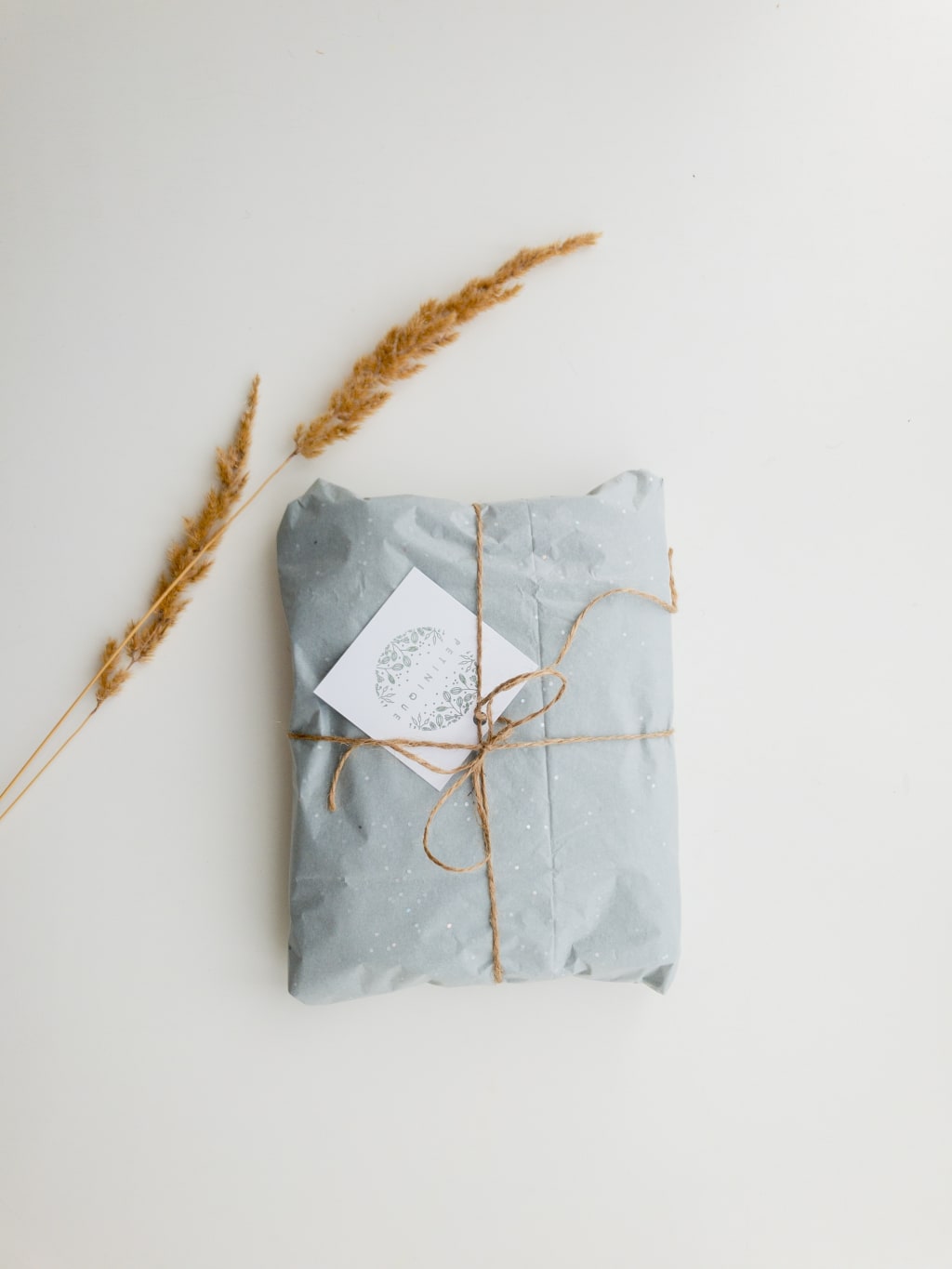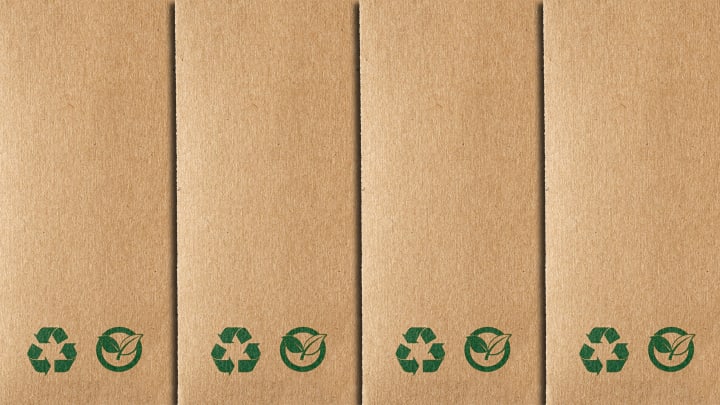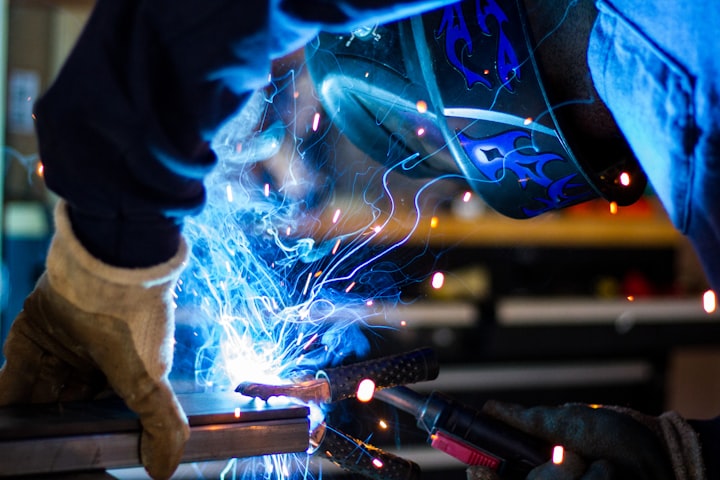How To Make Your Brand Packaging Eco-Friendly
In the wave of eco-conscious consumerism, it is likely that sellers will work harder to make packaging more eco-friendly. Here are some tips to help you do so!

The average American generates 4.4 pounds of trash daily. Packaging alone accounts for 30% of that number. In today’s eCommerce world, especially with services like Amazon Prime , free and one-day shipping has become the norm. People love the convenience of online shopping, but it’s creating greater waste and damage to the earth.
This exponential uptick in eCommerce means more packages—and less intentionality in the distribution process. Consumers are becoming more aware and conscious about their purchasing decisions, especially when it comes to unnecessary waste in their packaging.
Why does your brand need eco-friendly packaging, and what can you do to make more environmentally conscious distribution processes?
Recyclable material including paper bags and plastic bottles on a wood background with a green recycling symbol in the middle
Why use eco-friendly packaging?
As an eCommerce business, there are three main reasons to utilize environmentally friendly packaging and processes: sustainability, consumer, and cost.
1. Reducing your carbon footprint is a responsible decision as a business. You want to be aware of how your company is impacting the local and global world around you. Our businesses today are the future for tomorrow. The more sustainable your practices, the longer you can stay in business.
2. Today’s consumer is conscious of their waste. The web allows us to be an interconnected, global world with transparent access to information about how businesses are impacting our future.
Consumers are demanding change. 53% of consumers would pay a premium for green products and brands. Moreover, 86% of American consumers expect companies to be socially- and environmentally-conscious.
Millennials and Gen Z consumers especially expect this level of social responsibility. If your sustainability efforts can appeal to these customers, you’re more likely to gain loyalty and repeat business from this high-ticket audience.
3. In the long run, green packaging and reduced waste actually saves you a significant portion of your profits. Once implemented, these eco-friendly options are actually cheaper and more effective for most online brands. Plus, there are some financial incentives and tax deductions if your business takes certain sustainability measures.
Amazon has shown a commitment to reducing their packaging waste. They try to put as little as possible in their boxes. Sometimes you’ll open an Amazon box and there’s just the product inside without any additional packaging materials. This dedication to green practices is encouraging other online retailers to make leaps and bounds in their eco-friendliness as well.
Despite these efforts, though, it’s still not enough. If you want to fully optimize on the benefits of being a sustainable company, you need a plan for your brand’s packaging.
So what can you do to improve the eco-friendliness of your brand’s packaging?
Focus on minimalist packaging.

For a year or two, “unboxing” was the cool trend. But customers quickly started to realize the wastefulness of this process.
You can still optimize on this trend by focusing on eco-friendly unboxing. If your customers know that minimalism is the focus of your “unboxing process,” the greenness becomes part of your brand.
Focus on a clean aesthetic. This will make you stand out from competitors with heavier packaging, and consumers will like the sleekness.
Note: This means reducing the text and pictures on your packaging. Ink can actually be one of the most costly and wasteful parts of your packaging process. The more “naked” your packaging, the more sustainable it is. If you need to use ink, focus on soy inks, which are more sustainable and renewable. Soy ink can also be de-inked easily, which makes it easier for the recycling process.
A minimalist, cylindrical, cardboard package sits centered on a white background
Minimize the size.
The less the product weighs, the more you save on energy and fuel. You’re using fewer materials, which cost less and minimize packaging. You’re also using up less space and weight, which allows you to optimize during the warehousing and shipping process.
There are three ways to minimize the size.
First, trim the fat off of your boxes. You don’t want to have huge boxes for a small product. It’s a waste of space and materials, and it will cost you more in storing and shipping. The best way to do this is with custom packaging.
Second, use lighter weight materials. Heavy materials can increase fuel and energy costs. For example, although glass is recyclable and clean, it’s usually too heavy for large-scale shipping. Focus on paperboards and air cushions, which are especially lightweight. Plastic is also lightweight, especially compared to aluminum, steel, glass, and cardboard. Plastic also needs less energy in manufacturing.
You should also try to reduce or cut down on the number of packaging layers. You don’t need a “Russian doll” of boxes, where there are a number of boxes holding one product. You only need enough materials to keep the product safe.
Third, consider investing in artificial intelligence or other tech systems. These can help analyze your products and boxes to most effectively package and ship goods. This is one of the smartest ways to optimize your packaging and trim off extra fat. We recommend checking out Skubana, a smart inventory system.
Use biodegradable or recyclable materials.
What are the eco-friendly packaging products you should be using Cardboard, paperboard, and plastic are the easiest materials to recycle and recreate new items.
If possible, opt for biodegradable plastic as opposed to traditional plastics. Biodegradable plastic will start to decompose naturally when exposed to sunlight.
Cornstarch is a biodegradable package that has almost no negative impact on the environment. It works well for food packaging or package inserts.
Bubble wrap made of recycled polyethylene is fully degradable. This works well to keep your products safe in transit.
Air cushion rolls are the “new and improved” bubble wrap because they’re recyclable, save storage space, and are more cost-effective. Be sure to avoid Styrofoam as a means of shock absorption. This isn’t recyclable, and it’s especially bad for the environment.
Bagasse is a sugar pulp fiber that can also work well as sturdy packaging to avoid product damage. You can find similar products made of reed or glass fibers as well.
Talk to a packaging manufacturer to find recyclable materials that will best meet your budget and product needs.
Offer high-quality, reusable materials.
You can also make your packaging reusable by the consumer. For example, you can offer reusable bottles for your drinks. Or you can send your jewelry in high-quality bags that consumers can reuse.
If you’re going to use cardboard and plastics, try to make it as high quality as possible. Higher quality bags and boxes encourage consumers to reuse rather than throw it away. Plus, when the customer reuses the box or bag, they’ll remember your brand, which helps boost impressions and spur brand loyalty.

Match your brand.
Make “green” part of your brand. If sustainability is part of your brand mission, you’re more likely to make strategic decisions that align with that mission. This level of sustainability can help create a specific brand voice for your business and position you within your competitive atmosphere.
Check out some of these cool ways that businesses have incorporated eco-friendly packaging into their branding. For example, Nike Air Max shoes are packaged in an air cushion. This created an aesthetic that reflects the brand while also using fewer materials. It’s also an effective advertising strategy because you can see the product through the package, which excites and delights the customer.
Make sustainability a part of your brand to optimize on the consumer and cost benefits at every point of your distribution chain.
Conclusion
The most important part of packaging is ensuring that the product arrives intact. If the item arrives broken, the consumer will likely return it and leave negative feedback, which can kill your business.
Focus on practical packaging that is minimal and light. Make it clean and green. Eco-friendly packaging can reduce your carbon footprint, appeal to your consumers, and lower your costs.
Sustainability is the strongest way to grow your brand into the future.
Seller’s Choice is a digital marketing solution provider dedicated to the interests, growth, and profitability of e-commerce brands. For more updates, industry news, and e-commerce expertise, visit our site or get in touch.
About the Creator
Seller's Choice
Seller’s Choice is a digital marketing solution provider dedicated to the interests, growth, and profitability of e-commerce brands.






Comments
There are no comments for this story
Be the first to respond and start the conversation.